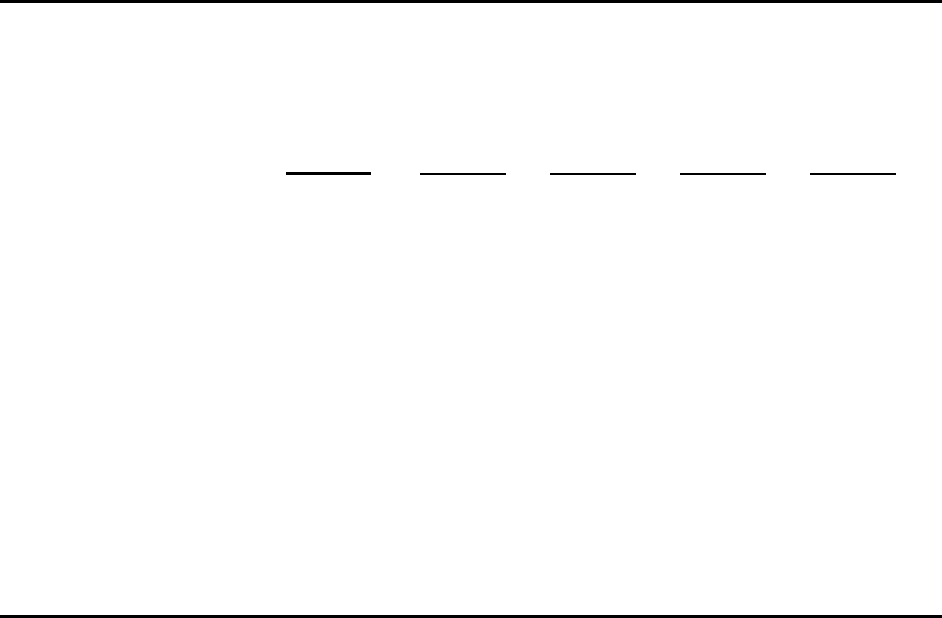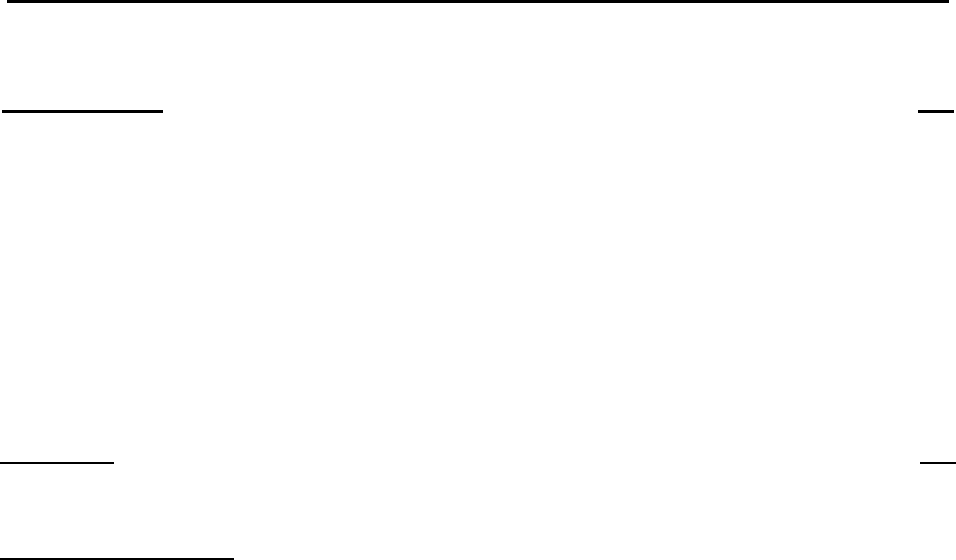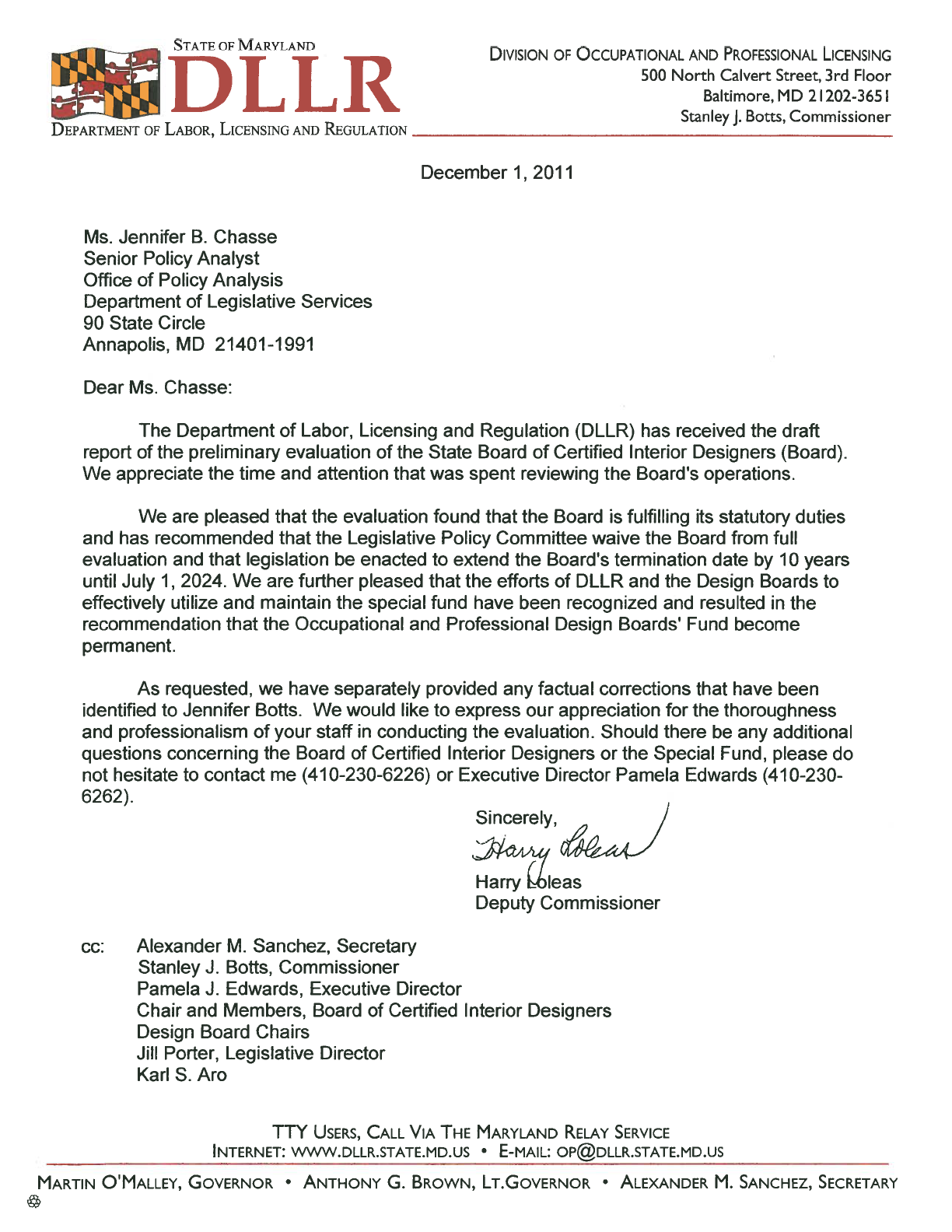
Prepared by: Jennifer K. Botts ● Department of Legislative Services ● Office of Policy Analysis
December 2011
1
Preliminary Evaluation of the
State Board of Certified Interior Designers
Recommendations: Waive from Full Evaluation
Extend Termination Date by 10 Years to July 1, 2024
Make the State Occupational and Professional Licensing
Design Boards’ Fund Permanent
The Sunset Review Process
This evaluation was undertaken under the auspices of the Maryland Program Evaluation
Act (§ 8-401 et seq. of the State Government Article), which establishes a process better known as
“sunset review” because most of the agencies subject to review are also subject to termination.
Since 1978, the Department of Legislative Services (DLS) has evaluated about 70 State agencies
according to a rotating statutory schedule as part of sunset review. The review process begins
with a preliminary evaluation conducted on behalf of the Legislative Policy Committee (LPC).
Based on the preliminary evaluation, LPC decides whether to waive an agency from further
(or full) evaluation. If waived, legislation to reauthorize the agency typically is enacted.
Otherwise, a full evaluation typically is undertaken the following year.
The State Board of Certified Interior Designers last underwent a preliminary evaluation as
part of sunset review in 2001 – the first sunset evaluation since the board’s creation in 1991. The
evaluation found that, although the board was successfully fulfilling its responsibilities to the best
of its abilities, the limited nature of the statutory structure prohibited the board from regulating the
practice of the profession as a whole and raised the question of whether doing so was necessary to
maintain and protect public welfare and safety. Accordingly, the board underwent a full
evaluation in 2002. Numerous findings and recommendations arising from that evaluation will
be discussed in greater detail later in this report. Ultimately, Chapter 227 of 2003 extended the
board’s termination date by 10 years to July 1, 2014.
In conducting this preliminary evaluation, DLS staff reviewed applicable State law and
regulations; recent legislative and regulatory actions; board minutes; prior sunset reviews; and
other information provided by the board regarding revenues, expenditures, examinations,
licensing, complaints, and disciplinary actions. In addition, DLS staff interviewed or
corresponded with current and former members of the board; the executive director; board
administrative staff; the Deputy Commissioner of Labor, Licensing, and Regulation; the Executive
Director of the National Council for Interior Design Qualification (NCIDQ); and representatives
of the Maryland Coalition of Interior Designers.
2 Preliminary Evaluation of the State Board of Certified Interior Designers
The board reviewed a draft of this preliminary evaluation and provided the written
comments attached at the end of this document as Appendix 2. Appropriate factual corrections
and clarifications have been made throughout the document; therefore, references in board
comments may not reflect the final version of the report.
The Interior Design Profession
The interior design professional plans and designs interior residential, institutional, and
commercial building spaces. More specifically, interior designers prepare and administer design
documents, including drawings, schedules, and specifications, which pertain to furnishings,
layouts, fixtures, cabinetry, lighting fixtures, finishes, materials, and interior construction not
materially related to or materially affecting building systems. The work must comply with
applicable laws, codes, regulations, and standards. The scope of work performed by an interior
designer may not be construed as authorizing the practice of architecture or engineering as defined
under Maryland law, but interior designers may be involved in the movement of nonload-bearing
walls as long as there is no material impact on building systems. The practice includes access and
egress planning and barrier-free planning for individuals with disabilities. Knowledge of
building codes and standards and knowledge of product properties, including flammability,
toxicity, slip-resistance, indoor air quality, ergonomics, illumination, and acoustics, are also
aspects of the profession.
Certified interior designers in Maryland may also perform “design coordination” for a
project or portion of a project as long as they hold a current certificate issued by the board and have
adequate experience and knowledge to achieve the objective of the project or portion of the project
being coordinated. Design coordination is the review and coordination of services provided by
certified interior designers, architects, professional engineers, landscape architects, and
professional land surveyors. Certified interior designers must state in each of the interior design
documents that the document is not an architectural or engineering drawing, specification, or
design and is not to be used for construction of any load-bearing column, framing, wall, or
structure.
Although the terms “interior design” and “interior decorating” are often used
interchangeably, the two practices differ. Interior designers create functional building spaces,
while interior decorators focus more on furnishings, color schemes, fabrics, etc. NCIDQ
emphasizes that one primary difference between the two professions is that interior designers are
responsible for the elements of design that affect the health, safety, and welfare of the public.
NCIDQ offers the example that, while an interior designer can evaluate wall finishes based on
criteria such as durability, acoustic properties, flame retardancy, and toxicity, an interior decorator
can evaluate finishes based only on color, style, and texture.
NCIDQ is the national organization setting standards for interior design professionals.
Passing the NCIDQ examination is required for certification as an interior designer in Maryland.
Most states that regulate the interior design profession, including Maryland, are members of
NCIDQ.

Preliminary Evaluation of the State Board of Certified Interior Designers 3
Regulation of Interior Design
Interior designers in Maryland operate pursuant to a “title act.” A title act contains a
statutorily defined scope of work that includes examples of the types of services provided by
members using the protected title. A title act does not preclude other individuals from performing
the same services as long as they do not use the protected title to describe themselves or their work.
In Maryland, the protected title is “certified interior designer.” In contrast, a practice act defines
activities that require specialized education, training, and examination before an individual is
granted the right to perform those activities and limits the ability to perform those activities to
those granted licensure or certification under that act. Individuals granted rights under a practice
act must satisfy statutorily defined criteria. An unlicensed or noncertified individual would be in
violation of the practice act if they performed the duties of a licensed or certified individual.
Approximately half of the jurisdictions within the United States, including the District of
Columbia and Puerto Rico, regulate interior design professionals. According to NCIDQ,
four states (Alabama, Florida, Louisiana, and Nevada) and the District of Columbia have practice
acts. The remaining jurisdictions (including Virginia) have title acts. Delaware and
Pennsylvania are among the states that do not regulate interior designers. Mississippi, the most
recent state to regulate the profession, will operate under a title act. HB 1168 of 2009 proposed
establishing a practice act in Maryland, but the bill was withdrawn.
The State Board of Certified Interior Designers
Chapter 663 of 1991 (the Maryland Certified Interior Designers Act) established the State
Board of Certified Interior Designers, which regulates the title of “certified interior designer.” As
noted above, the Act and the board do not pertain to interior designers who do not use the title
“certified interior designer.” The Act also does not apply to architects.
The board is one of five “design boards” under the Department of Labor, Licensing, and
Regulation’s (DLLR’s) purview.
1
The interior design board is the only design board that does not
operate pursuant to a practice act. The board consists of seven members: five certified interior
designers, one licensed architect who provides interior design services, and one consumer. All
five interior designer members must have at least five years of experience immediately prior to
appointment. The architect member must have practiced in the State for at least five years
immediately before appointment. The consumer member may not be licensed or otherwise
subject to regulation by the board, may not be required to meet the qualifications for the
professional members of the board, and may not, within the year before appointment, have had a
financial interest in or have received compensation from a person regulated by the board. In
addition, while serving as a member of the board, a consumer member may not have a financial
interest in or receive compensation from a person regulated by the board, or grade any examination
1
The five design boards are the State Board of Architects, State Board of Certified Interior Designers, State
Board of Examiners of Landscape Architects, State Board for Professional Engineers, and State Board for
Professional Land Surveyors.
4 Preliminary Evaluation of the State Board of Certified Interior Designers
given by or for the board. Although the inclusion of a board member from another discipline is
unusual for Maryland (i.e., none of the other design boards has a member from another design
profession), NCIDQ estimates that 13 of its member jurisdictions have joint boards with architects.
All members of the board are appointed by the Governor and serve three-year staggered
terms that begin on July 1. Board members continue to serve after their term has ended until a
successor is appointed. Although board members do not receive compensation, they are eligible
for reimbursement of expenses. The Governor may remove a member for incompetence or
misconduct. Pursuant to one of the recommendations in the 2002 full sunset evaluation of the
board, a member may serve no more than three consecutive years as an officer of the board. The
board has two vacancies at this time (one certified interior design member and the architect
member); both positions have been vacant since May 2011. The board generally meets four times
each year. The board meets less often than other design boards; however, the meeting frequency
seems to be adequate for the work of the board. If the board were to enhance consumer outreach
or undertake any initiatives, additional meetings might be necessary.
DLS noted in the 2001 preliminary evaluation that the board seemed to spend a
considerable amount of time reviewing which courses should be approved for use as continuing
education credits. Although the board minutes from the past three years still reference this issue,
the board has streamlined the process in recent years. For example, after noting in the
May 14, 2008 board meeting that a lengthy discussion of every application for continuing
education course approval seemed unnecessary, a process was developed to allow the continuing
education committee to make recommendations to the board for approval or denial that may be
voted on without discussion. Applications presenting unique issues or problems may still be
brought to the full board and discussed. The board also maintains a list of approved courses on its
website.
Shared Staffing Sufficient for Board Needs
The board has four regular and two contractual staff members available to it.
One position, board secretary, is shared with the State Board for Professional Engineers. All
other positions, which are the executive director, an assistant executive director (this position has
been vacant since August 2011), an investigator, and two contractual employees – an office
secretary and an outreach coordinator – are shared among all of the design boards. The board also
receives legal assistance from DLLR and other clerical and licensing assistance from the central
staff of the Division of Occupational and Professional Licensing within DLLR. Though staffing
is shared, it appears sufficient to meet the administrative needs of the board, assuming that the
assistant executive director position does not remain vacant.
Preliminary Evaluation of the State Board of Certified Interior Designers 5
Legislative Changes Affecting the Board Since the 2001 Preliminary
Sunset Review
As shown in Exhibit 1, only a handful of legislative changes have affected the board since
the last preliminary sunset review in 2001. Chapter 383 of 2002 requires certified interior
designers to obtain a seal to endorse documents. Certified interior designers must sign, seal, and
date any interior design documents submitted to clients or public authorities. By placing the seal
and signature on design documents, the certified interior designer certifies that he or she has
exercised professional judgment in making decisions as to all matters contained within the
document and that he or she prepared them or directly controlled and supervised their preparation.
The ability to use this seal is extended only to interior designers who are certified by the board to
use the title “certified interior designer”; other individuals practicing interior design cannot use the
seal. Similarly, other regulated design professionals use seals to certify their documents. The
board is authorized to reprimand a certificate holder or suspend or revoke a certificate if the
certificate holder signs or seals any interior design documents after the certificate holder’s
certificate has expired or has been suspended or revoked.
Chapter 129 of 2005 lowered the standard for disciplinary actions against certificate
holders by removing the requirement that an individual “knowingly” committed a violation.
Chapter 129 also broadened the scope of violations for which the board may take a disciplinary
action by making a violation of any regulation adopted by each board to be the basis for a
disciplinary action.
As previously mentioned, the board underwent a full sunset evaluation in 2002.
Following that evaluation, DLS concluded that continued regulation of certified interior designers
was unnecessary because there was no risk of serious injury or financial damage to the public from
the unregulated practice of the profession. Accordingly, DLS recommended that the General
Assembly repeal the board and provide for the phase out of certification for current certificate
holders. However, the same report presented an alternative series of recommendations by DLS if
the General Assembly chose to continue protecting use of the title of “certified interior designer.”
Term limits for the board members were recommended as was better recordkeeping and more
outreach. Other recommendations concerning all of the design boards will be discussed later in
this report. Ultimately, the alternative series of recommendations was adopted, and Chapter 227
of 2003 extended the termination date of the board by 10 years to July 1, 2014.

6 Preliminary Evaluation of the State Board of Certified Interior Designers
Exhibit 1
Major Legislative Changes Since the 2001 Preliminary Sunset Review
Year
Chapter
Change
2002
383
Requires certified interior designers to obtain a seal and to sign, seal, and
date any interior design documents submitted to clients or public authorities.
Authorizes the board to take disciplinary action against a certificate holder
who signs or seals a document after the certificate has expired or has been
suspended or revoked.
2003
227
Extends the termination date of the board by 10 years from July 1, 2004, to
July 1, 2014.
Requires the chairs of the five design boards to meet annually to discuss
issues of mutual importance and post a joint newsletter on the DLLR
website.
Establishes a State Occupational and Professional Licensing Design
Boards’ Fund, a special fund for the collection of license and permit fees
from the five design boards.
Repeals license and permit fees set in statute and instead requires the
Secretary of Labor, Licensing, and Regulation to calculate the direct and
indirect costs attributable to each of the design boards and to establish fees
based on those calculations.
Caps any fee increase by a design board at no more than 12.5% annually.
2005
129
Lowers the standard for specified disciplinary actions against a certified
interior designer applicant or licensee by removing the requirement that an
individual “knowingly” committed a violation.
Broadens the scope of violations by making a violation of any regulation the
basis for a disciplinary action.
2008
273
Extends the termination date to June 30, 2013, for the special fund that
serves all five design boards and related provisions, including the board’s
fee-setting authority.
Note: The five design boards include State Board of Architects, State Board of Certified Interior Designers, State
Board of Examiners of Landscape Architects, State Board for Professional Engineers, and State Board for
Professional Land Surveyors.
Source: Laws of Maryland
Preliminary Evaluation of the State Board of Certified Interior Designers 7
DLLR Design Boards Work Cooperatively and Share Special Fund
As mentioned previously, there are five design boards within DLLR, including the State
Board of Certified Interior Designers. The other boards regulate architects, landscape architects,
professional engineers, and professional land surveyors. Chapter 227 of 2003, which extended
the board’s termination date, also established the State Occupational and Professional Licensing
Design Boards’ Fund as a special, nonlapsing fund in DLLR. One of the major goals of this Act
was to cluster the design boards, since they regulate similar types of professions, in order to
equalize the licensing fees among the design professions. Through this clustering approach, the
Act required the design boards to work more cooperatively together through a Joint Chairs
Committee. The creation of the special fund and the formalization of the Joint Chairs Committee
were implemented in response to recommendations made by DLS in the 2002 full sunset
evaluation of this board. The special fund will be discussed in greater detail later in this report.
Chapter 227 of 2003 also requires that the chairmen of each of the five design boards meet
annually to discuss issues of mutual importance and publish a joint newsletter. The Joint Chairs
Committee meets several times a year and has proven to be a useful and efficient way for the
design boards to communicate amongst themselves and with DLLR. The Joint Chairs
Committee serves as an effective forum for the design boards to share ideas, work
cooperatively, and support the combined interests of the design industry as a whole in the
State.
Certification of Interior Designers
To be eligible for certification, an individual must meet the education and experience
requirements necessary to qualify and pass the NCIDQ exam. Prior to sitting for the exam, a
candidate must have a combination of six years of education and work experience, which can be
accomplished through several different paths. The board does not administer the exam, but its
membership in NCIDQ guarantees that at least one exam will be offered annually within the State.
Although the exam covers a broad range of matters that interior designers use in their daily
practice, it only tests knowledge and skills that protect public health, safety, and welfare
(e.g., design history and furniture styles are not covered). Approximately every five years,
NCIDQ surveys practicing professionals to identify and ensure that the exam reflects changes in
interior design practice. Its last practice analysis was in 2008. Based on that data, the current
exam consists of the following three sections, all of which must be completed to pass the exam:
Section 1. Codes, Building Systems, Construction Standards, and Contract
Administration. This is a multiple choice test consisting of 150 questions. The
knowledge and skills tested in this section include code requirements such as accessibility
guidelines; building systems and construction; measuring, drafting, and technical drawing
conventions; and construction documents and architectural woodworking.
8 Preliminary Evaluation of the State Board of Certified Interior Designers
Section 2. Design Application, Project Coordination, and Professional Practice.
This is also a multiple choice test with 150 questions. It addresses topics including
sustainable design practices; written and verbal design communication methods and
techniques; business practices and ethics; the relationship between human behavior and
design; and site analysis procedures.
Section 3. Practicum. Candidates are given a series of exercises covering space
planning, lighting design, egress, life safety, restroom design, systems integration, and
millwork design. Candidates must produce plan drawings and develop appropriate
specifications and schedules. Work product must address codes and the principles of
universal design.
Certification by Reciprocity
The board may waive the examination requirement for an individual licensed or certified as
an interior designer in another state having similar requirements to Maryland’s. However, the
individual has to pay the application fee; the applicant’s home state has to provide reciprocity; and
the applicant’s home state certification or licensing requirements have to be substantially
equivalent to Maryland’s. Although the board does not keep data on how many reciprocal
certificates it has issued, DLLR staff indicated that few have been issued.
Certificates Renewed on a Biennial Basis; Continuing Education
Required
Certificates must be renewed on a biennial basis. Certificate renewal can be done
electronically through the DLLR website, and there is a renewal fee of $68. For late renewals by
individuals, there is a $100 reinstatement fee.
One continuing education unit (CEU) is required for a timely renewal and certified interior
designers must earn two CEUs in the two-year period immediately preceding a reinstatement
request. One CEU equals 10 hours of study. Regulations require that the course must contribute
directly to the enhancement of professional competency of an individual to provide interior design
services and have the protection of health, safety, and welfare of the public as a clear purpose and
objective. Marketing courses, unless otherwise determined by the board, are generally not
approved for CEUs. At the October 3, 2008 board meeting, after noting that a similar
requirement had been adopted in Texas, it was recommended that the board amend its regulations
to require one hour of “sustainable design” education. This regulation was finalized June 29,
2009 (Code of Maryland Regulations, 09.18.03.02-03).
When individuals renew their certificates online, approximately 5% to 10% of applications
are randomly selected to be audited. Those individuals must submit proof of compliance to the
board. The board voted at its July 19, 2010 meeting, to propose regulations to make it a violation
of the code of ethics to fail to respond to a communication from the board. Regulations to this
effect were finalized June 13, 2011 (Code of Maryland Regulations, 09.18.02.07).

Preliminary Evaluation of the State Board of Certified Interior Designers 9
Certification Activity Has Remained Relatively Stable
Exhibit 2 shows certification activity for fiscal 2007 through 2011. During that five-year
period, the board issued almost 130 original certificates and renewed over 650. Although the
number of original certificates issued spiked in fiscal 2008 before leveling off, board staff cannot
recall any specific reason for the increase. DLS notes that due to the two-year renewal cycle, the
spike in original licensing should have equated to a higher number of renewals in fiscal 2010;
however, renewals in fiscal 2010 were instead on par with fiscal 2008 renewals. Although the
board could not conclusively explain the attrition rate, several members did note that the economic
environment has hit the design industry hard and could explain the lack of renewals to some
extent.
Exhibit 2
Certification Activity
Fiscal 2007-2011
FY 2007
FY 2008
FY 2009
FY 2010
FY 2011
Total
Average
Certificates – Original
19
37
23
25
24
128
26
Certificates – Renewal
112
145
126
146
138
667
133
Source: State Board of Certified Interior Designers
As of November 4, 2011, there were 315 active certificate holders in the State. As a point
of reference, there were 288 certificate holders at the time of the 2002 sunset evaluation.
One recommendation from that evaluation was for the board to improve its recordkeeping related
to the number of interior designers. Information regarding certification activity was readily
available from the board for this sunset evaluation, and minutes from prior board meetings indicate
that DLLR staff gives the board updates on the current number of certificate holders at each board
meeting.
Board Receives Few Complaints Against Certified Interior Designers
The board has the right to fine, reprimand, suspend, or revoke the certificate of a certified
interior designer who obtains or uses the title fraudulently or deceptively or who violates any of the
regulations relating to the board. Regulations include a code of ethics, which gives the board the
authority to hear complaints pertaining to the unprofessional practice of interior design by certified
interior designers. Due to the nature of the act governing certified interior designers, the board
has no authority to hear complaints of any kind concerning the practice of interior design by
noncertified interior designers. According to board staff, the board has received only
two complaints in the past five fiscal years. One involved an allegation of an ethics violation,
10 Preliminary Evaluation of the State Board of Certified Interior Designers
while the second involved misrepresentation. Both complaints were closed with no action.
Available Financial Resources Cover Board Operations
As discussed earlier, a pilot program established by Chapter 227 of 2003 created a State
Occupational and Professional Licensing Design Boards’ Fund to ensure that costs for the
five design boards, in the aggregate, were covered by their revenues, in the aggregate. The fund
and fee-setting authority were set to terminate on June 30, 2008; however, Chapter 273 of 2008
extended the termination date for the special fund to June 30, 2013. Prior to the enactment of
Chapter 227, the fees for the board were set in statute, the revenues were credited to the general
fund, and the Governor included a general fund appropriation for the board within the budget of
DLLR.
Since 2003, the Secretary of Labor, Licensing, and Regulation has been charged with
annually calculating the direct and indirect costs attributable to each of the design boards and
providing this information to the boards. With consent of the boards, the Secretary is authorized
to average the direct and indirect costs among the boards in order to establish fees that more
equitably distribute the costs associated with the operation of each board across all five boards.
With these calculations in mind, the board is charged with setting reasonable fees for its services
by regulation. The fees charged are required to be set so as to produce funds to approximate the
cost of maintaining the boards and may not be increased more than 12.5% over the previous year’s
fees.
In 2007, the design boards determined that the fund balance merited a fee reduction, and
the across-the-board license fee of $78 was reduced to the current fee of $68. Prior to the
enactment of the special fund, the board charged a $50 application fee and a $150 fee for an
original certificate. Renewal fees were $200. Appendix 1 provides the board’s current fee
schedule.
As shown in Exhibit 3, although the board’s revenues have never been sufficient to cover
expenditures, when the board’s revenues are combined with the revenues of the other design
boards, it does not actually operate with a deficit. This was the legislative intent of Chapter 227,
which created the special fund. The fiscal 2011 ending balance for the fund was $240,691. It
should also be noted that the Budget Reconciliation and Financing Act of 2010 (Chapter 484)
redirected $300,000 from the design boards’ special fund to the general fund in fiscal 2010.
Because the design boards have demonstrated the ability to properly maintain the special
fund, DLS recommends that legislation be enacted to make the special fund permanent.

Preliminary Evaluation of the State Board of Certified Interior Designers 11
Exhibit 3
Fiscal History of the State Board of Certified Interior Designers
Fiscal 2007-2011
FY 2007
1
FY 2008
FY 2009
FY 2010
FY 2011
Total Revenues
$14,370
$15,766
$13,850
$13,854
$15,586
Total Costs
117,060
37,957
40,814
50,290
34,854
Direct Costs
97,413
29,461
26,305
40,432
28,175
Direct Legal Costs
6,961
6,091
11,924
7,072
3,631
Indirect Costs
12,686
2,405
2,585
2,786
2,498
Surplus/(Deficit)
($102,690)
($22,191)
($26,964)
($36,436)
($19,268)
1
Prior to fiscal 2008, there was significant variation in accounting for direct costs and indirect costs for all of the design
boards. DLLR advises that there were issues in the board’s budget (as with the budgets for other design boards) for
these years because the department was implementing new accounting standards and bringing on a new accounting
team.
Source: Department of Labor, Licensing, and Regulation
The board’s direct costs include salaries and benefits for staff, office supplies, and legal
fees from the Office of the Attorney General within DLLR. Costs incurred at the level of the
Division of Occupational and Professional Licensing (including central licensing, the telephone
center, the commissioner’s office, and information technology costs) are coded as reimbursable
funds and are also included within the board’s direct costs, consistent with guidance from the
Department of Budget and Management. The board’s indirect costs are incurred at the
departmental level and include costs for activities and services related to budget, personnel,
general services, and the Office of the Secretary.
Revenues and expenditures for the board have been relatively constant since fiscal 2008
when the new accounting standards were implemented. Higher revenues in fiscal 2007 were due
to the higher fees that were charged prior to the fee reduction, while higher revenues in fiscal 2008
corresponded with the increase in certificates issued that year. Revenues were also higher in
fiscal 2011 due to a high number of late renewals (16).
Legal fees were particularly high in fiscal 2009, which DLLR staff indicated was due to
regulations that were prepared during that timeframe, as well as the increased need for legal
services resulting from the “practice act” legislation that was introduced in the 2009 session.
Direct costs for the board were also higher than usual in fiscal 2010. DLLR indicates that direct
costs were higher that year in part because the board was fully staffed; while in other fiscal years
there were some vacancies that resulted in lower personnel costs (e.g., the outreach coordinator
position was vacant during most of fiscal 2011 and the executive director position was vacant
12 Preliminary Evaluation of the State Board of Certified Interior Designers
during portions of fiscal 2011 as well). In addition, two years of annual dues for NCIDQ ($3,625)
were paid during fiscal 2010, which also helps account for the higher direct costs that year.
Recommendations
Although the work of the board is limited by the current statutory “title act” structure, the
board is fulfilling its statutory duty of protecting the title of “certified interior designer.” The
board has taken steps to ensure that members of the public who choose to engage the services of a
“certified interior designer” are afforded the most protection possible, by monitoring compliance
with continuing education requirements and taking steps to make sure that the requirements stay
current, as evidenced by the adoption of the “sustainable design” regulation. The board has also
improved outreach specific to interior designers by improving its website and participating in
design conferences and exhibitions. It has also made efforts to improve educational opportunities
in the State for prospective interior design students by initiating communication with schools to
develop interior design programs. Furthermore, the implementation of the Joint Chairs
Committee and its newsletter has improved communication to the design community as a whole.
Including certified interior designers in the cluster of design boards enhances design coordination
on projects and allows opportunities for consumer protection by requiring and regulating the use of
the seal. Finally, past actions of the General Assembly appear to indicate the intention to continue
the board and its regulation of certified interior designers as a title act. Consequently, DLS
recommends that LPC waive the board from full evaluation and that legislation be enacted
to extend the board’s termination date by 10 years to July 1, 2024, and to make the design
boards’ special fund permanent.

13
Appendix 1. Schedule of Fees for the
State Board of Certified Interior Designers
License Fees
Type of License
Fee
Interior Design Certificate Fee – New and Biennial Renewal
$68
Application Fee
35
Reinstatement of Certificate
100
Reciprocal Certificate Application Fee
50
National Council for Interior Design Qualification (NCIDQ) Fees
1
Initial Fees
Fee
Application Review Fee
$165
Exam Fees Per Section
Section 1. (Codes, Building Systems, Construction Standards, and Contact
Administration
255
Section 2. (Design Application, Project Coordination, and Professional Practice
255
Section 3. (Practicum)
390
1
These fees are set by and paid directly to the National Council for Interior Design Qualification.
Source: Code of Maryland Regulations, 09.18.01.03; National Council for Interior Design Qualification
14

15
Appendix 2. Written Comments of the
State Board of Certified Interior Designers
16

